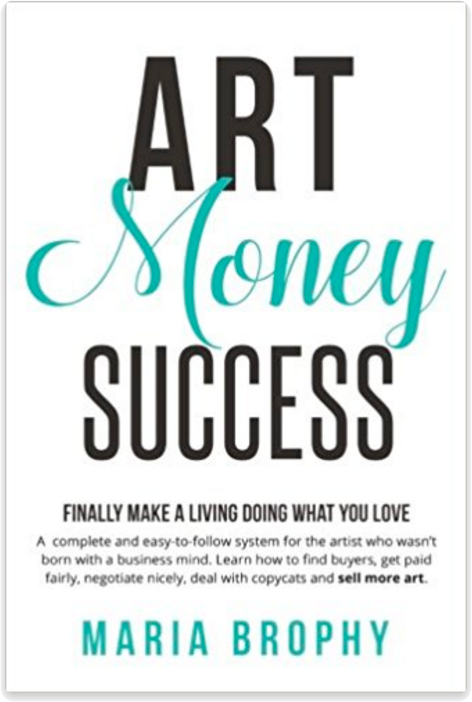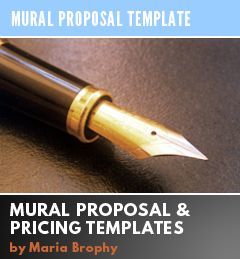“It is one thing to license one design or collection with a company to see how it goes. It’s like going on a blind date – you see what happens. But it is quite another to tie your wagon to a company for 2-3 years.” Artist Tara Reed
Before signing any document that has the word “Exclusive” in it, be aware of what you are giving away.
This advice applies to all business arrangements, no matter what niche you work in.
In the world of art sales, licensing and exhibit shows, often we get asked to sign an exclusive agreement, and most of the time, I won’t. I’ll explain why – read on:
WHAT DOES EXCLUSIVE MEAN? When you agree to give someone an exclusive, it means that you cannot sell your goods or services to anyone else for the term of the agreement.
Occasionally, signing an exclusive can make sense. But usually it does not.
REASONS NOT TO SIGN AN EXCLUSIVE AGREEMENT:
- You are shut off from other opportunities when you sign an exclusive.
- The company asking for an exclusive isn’t offering any extra money or incentive for giving it to them.
- If the project, exhibit or product fails, you may still be tied to the exclusive, and now you aren’t making any money off of it at all, nor can you go elsewhere to earn from it.
- The most important reason of all: In the event of bankruptcy, the law will hold you to an exclusive, even if the company goes bust and isn’t able to pay you anymore. This is why in the licensing world, exclusives are rare. (My attorney says that including wording that says “should the company go bankrupt, this contract is void” does not solve this problem. The bankruptcy laws do not recognize or honor that language in a contract.)
- If there is no value to be gained from giving an exclusive, not for you or the person you’re granting it to.
I WAS GLAD WE ARGUED FOR A NON-EXCLUSIVE WITH SPORT-FUN TOY COMPANY:
We signed a licensing deal with one of the largest U.S. toy companies for skateboards a few years ago. They demanded an exclusive. I held my ground, for all the reasons above. But I assured them that we wouldn’t do a skateboard license with a competing company (that would be stupid on our part). Eventually, they agreed to a non-exclusive. I kid you not, 6 weeks later they went bankrupt! And we were free to do a skateboard license with any other company. Had we agreed to the exclusive, we would have not been able to business with another skateboard company for 2 years, even though we weren’t earning from this license.
HOW DO YOU GET THE CLIENT/GALLERIST TO DROP THE EXCLUSIVE REQUIREMENT?
Don’t be afraid to question why they want an exclusive. Get to the bottom of what their real concern is by asking them what it is. And then find another way to give them what they need. You do this by having a grown-up conversation.
Just last week, a very important client that pays Drew to travel and paint at events asked that he sign an exclusive on his designs. I explained that we can’t because his designs are being used for other things. I asked why they wanted an exclusive. They said they were worried that their competitors would contact Drew and have him do the same work for them. After all, they hired Drew to do a special promotion that they are putting a lot of money into and they are paying us top dollar for it. I said okay, instead of giving an exclusive on the designs, why don’t we agree to not work with your direct competitors for one year? That way, we keep control over the designs, and they get the assurance they need. Everyone wins.
There’s always a way to give your client what they want without giving it all away. Just find out what they REALLY are after. I find with some companies they don’t even know why they want an exclusive. In one instance, a licensee insisted on one because his highly paid attorney said he should. But there wasn’t any reason behind it!
WHY EXCLUSIVE AGREEMENTS HURT GALLERY SALES:
In the case of galleries, they can act just like jealous teenagers. They don’t want anyone else to get what they think is theirs. But it’s dangerous to give a gallery complete control over your entire career.
There is a gallery in Newport Beach, California that asked my husband Drew to exhibit his artwork. The gallerist handed us an “exclusive” consignment agreement. This meant that Drew couldn’t exhibit his art in any other gallery, ANYWHERE IN THE WORLD.
“Why do you need to have an exclusive? You don’t have locations else-where, do you?” I asked. The answer was no. They had only one location, but wanted to make sure that nothing was sold from their artists anywhere else! This thinking is completely backwards, and here’s why, as I explained to the gallerist:
If Drew isn’t exhibiting anywhere else in the world, it’s not going to help the sales of his art anywhere, including in YOUR gallery. It will hurt ALL sales. He didn’t see my point, but granted, he was pretty stubborn.
After some going back and forth on it, the gallerist removed the word “exclusive” and we agreed to not exhibit at any gallery in the actual town that the gallery was in. That seemed fair and made sense. The world-wide exclusive was just silly. I found out later that other artists with that same gallery made the mistake of signing his exclusive agreement, which had a 5 year term!
I discovered this when an opportunity to do a group show in a town 70 miles south of this gallery came up. I called one of the other artists that was in the gallery in Newport Beach and asked if they were going to do the group exhibit. “Oh, I can’t. I’ve signed an exclusive with the Newport Beach gallery and can’t do any other shows for 5 years.” Yikes.
By signing a world-wide exclusive, this artist can’t be a part of ANY art show ANYWHERE for any reason. He’s going to miss out on a lot of exposure. And guess who else misses out? The Newport Beach gallery.
They will have an artist with a shrinking, rather than growing, resume of shows and exhibits. Not good for high-end art sales.
The worst part is that this artist tells me that he sells less than a dozen paintings a year through the gallery in Newport Beach. The exclusive prevents him from making a living off of his art.
WHEN SIGNING AN EXCLUSIVE MAKES SENSE:
In some instances it makes sense to sign an exclusive – like when it means high-dollar stakes and massive sales.
We agreed to an exclusive Drew Brophy/Converse Chuck Taylor design to Journey’s shoes. That was in exchange for a large order, as they have 900 stores. But that exclusive had limits to it; it was for one specific design, not the entire category of shoes and the exclusive was only for summer 2010.
Here are some sensible reasons to sign an exclusive:
You are paid extremely well for that Exclusive through a Guarantee: A guarantee in the contract states that you are paid a minimum dollar amount regardless of what sells.
Example of a Minimum Guarantee: You are paid a minimum of $20,000 per quarter regardless of what actually sells. (The dollar amount should be what makes it worthwhile for you to not do work with anyone else). This way, if the company doesn’t properly sell your art, you are still getting paid for that exclusive.
The contract has a very short time period: Narrow it to one or two years, that way if the client or gallery doesn’t succeed selling your artwork, than you only lost a year or two of your career. Think long and hard before you sign a long term exclusive agreement (unless you are paid extremely well for it).
The contract has a very narrow geographical location: In the case of a licensee, narrow it to where they are actually selling your products (i.e. in North America).
In the case of gallery representation, narrow it down to the actual town that the gallery is in. If the gallery has multiple locations, than have the contract state all of those multiple towns (i.e. this contract is exclusive in Newport Beach, CA, Miami FL and Manhattan). That way you won’t miss out on other exhibits that could earn you a greater fan base and more sales.
The contract has a narrow list of items that are exclusive: An example would be a specific design for a specific product, such as: The design named “Pure Joy” for printing on 11” x 14” Lithographs.
Being specific allows you to free up all designs except those listed in the agreement. Trust me, after doing licensing for a few years, this will make sense to you.
There’s money up front: A large chunk of projected earnings up front before signing an Exclusive agreement ensures a commitment on the part of the person you are partnering with.
HONOR YOUR CLIENTS EVEN WITHOUT AN EXCLUSIVE
An exclusive isn’t needed to keep your integrity. You can assure your client or gallery that you will keep their best interest in mind without that legal limitation. All while keeping yourself free to pursue other opportunities should they go bankrupt, fail to market you as they promised, or drop the ball altogether.
Even though almost all of our agreements are non-exclusive, I am very careful not to do business with the competitors of our current clients. It would be unwise to ruin our existing relationships, and it goes against our personal code of values.
We are four years into a non-exclusive arrangement with manufacturer Coastal Classics. They print Drew’s art on t-shirts and sell them to surf shops and coastal gift stores. They sell very well. Last year their biggest competitor called asking if Drew would design t-shirts for them. Even though we don’t have an exclusive with Coastal Classics, we said no. It wouldn’t do anyone any good to have Drew’s art with 2 competing companies. It would be unethical, for one, and the other reason is that it would confuse the customers.
But, if Coastal Classics didn’t properly market Drew’s t-shirts and we didn’t see any income from that agreement, we might have considered doing business with their competitor. We would have been free to take on that opportunity.
The bottom line is that when you sign an agreement, pay attention to the important words that can bind you. Know what you are getting into, and what you are giving up.
Remember that everything is negotiable, and that most of the companies you work with will understand when you explain why you don’t want to agree to something that’s not in your best interest.
Be honest, up front and reasonable. As with everything else, just use your head!
Maria xxoo
PS: I found a great article by the very wise artist Tara Reed on the same topic. Read her point of view here: Five Things to Consider Before Signing an Exclusive Agreement.
.
 To gain a strong understanding of Art Licensing Contracts, what to charge, how to protect yourself in a deal, and so much more: Check out my e-Book, co-written with artist Tara Reed, called How to Understand Art Licensing Contracts.
To gain a strong understanding of Art Licensing Contracts, what to charge, how to protect yourself in a deal, and so much more: Check out my e-Book, co-written with artist Tara Reed, called How to Understand Art Licensing Contracts.
This eBook will save you years of experience, time & money. It will prevent you from getting into bad deals and show you what’s reasonable to ask for. You’ll feel more confident going into each deal with this reference by your side. It’s truly a must-have reference for all artists who are licensing their art!











6 Responses
Great points and fabulous food for thought all in one place. I’m honored to be a part of your post!
It is tricky, sometimes you just have to go with your gut. I have an exclusive contract with my fabric company and it is working great – it’s a partnership, we work well together and they regularly produce my designs on fabric. Other times it seems manufacturers want full commitment from you while offering you nothing – that is when you really need to scratch your head and ask the tough questions!
Tara
Awesome info!
Recently while hitting up my Florida beaches I noticed Drew’s art on shirts and stickers on the counter.
So great to see it around.
Great blog post Maria!
Yes – “Honor Your Clients” in an ethical manner always. Good stuff.
..Hey, don’t forget to link back to Drew’s site whenever you include a blip about his art. -:)
—– “There is a gallery in Newport Beach, California that asked my husband Drew to exhibit [ his artwork ]. ” —–
Good info thanx!